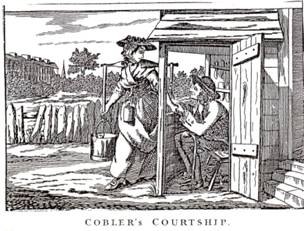Tom Patch
Tom Patch II grows up
By this time, Tom I’s mother was dead,8 presumably leaving him with the Yelvertoft cottage. His ownership of the West Haddon cottage and the land attached to it was enough to make him a ‘forty shilling freeholder’. This entitled him to vote in the General Elections of 1730 and 1748. Since secret ballots had not yet been introduced, we know that he voted Whig (liberal) in 1730 and Tory in 1748.9 The two surviving children grew up. A woolcomber called Sam Mabbott began courting Elizabeth, while her brother, Tom II, showed no inclination to leave home. Perhaps he lacked his father’s physical strength, perhaps the outdoor life held little appeal for him, perhaps he found craftsmanship rewarding. Whatever the reason, young Tom became a shoemaker.10 There is no record of a formal apprenticeship, but he must have found some way of learning the trade, which at this time was far less common in rural areas than the textile manufacturing that employed Sam Mabbott.
Then one September morning in 1756 their lives changed. Tom senior hadn’t been home all night. He’d been sent out, the evening before, into the open fields (for this was before Enclosure) by a farmer he worked for, to fetch in some horses that had been tethered on the common grazing. The night was dark - they called for him - but he didn’t answer. They found him in the morning, not a mark on him, ‘struck with sudden death’ as the local newspaper reported it.11 Here are echoes of his own father’s death, collapsed in the street and quickly carried to the nearest neighbour’s house. Were there heart problems in the family? Is that why Tom II opted for the shoemaker’s bench?
The cottage would have come to Tom II, probably with a life interest for his mother, which may have left his sister looking for the independence of a home of her own. The following year she married her Sam (only just in time – her baby arrived a couple of months later). That left Tom making shoes and his mother keeping house. Did his mother nudge him towards matrimony? Was she feeling her age and hoping for a younger woman to help around the house now that her daughter had gone? Did Tom feel he couldn’t yet afford to support a wife? Did he not get out much? He was 32 before he finally tied the knot with Mary Spokes – literally ‘the girl next door’.

Picture 5. An 18th century woodcut
8Yelvertoft parish register. 10.12.1737, Ann Patch, widow, buried.
9NRO Northamptonshire Poll Book.
10NRO 147p/152 Overseers’Accounts 1748-1770, p.202 Tom Patch paid for making shoes for Betty Hall’s boy.
11Northampton Mercury, 27.09 1756, p.103, column 3. "Last Monday morning Thomas Patch of West Haddon, labourer, who the night before was sent into the Fields to fetch some horses, was found dead. Supposed to have been struck with sudden Death."
